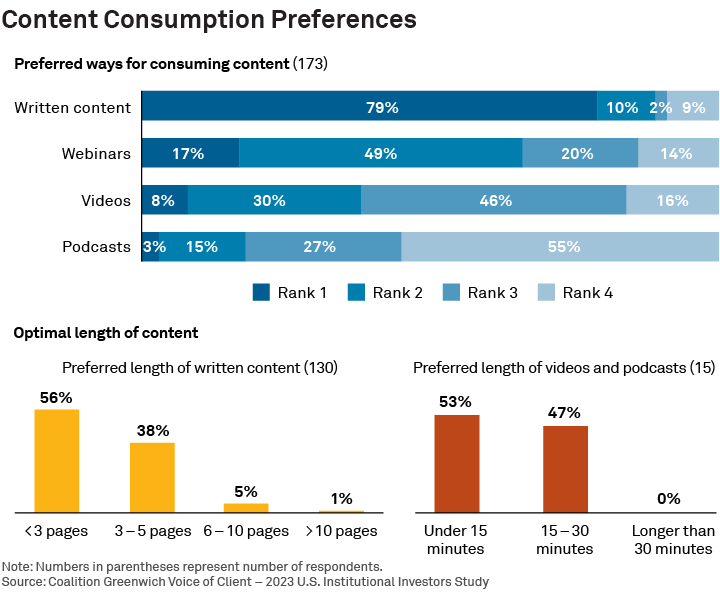
Investment data and market insights have never been more accessible. For most institutional investors, the challenge is no longer finding the information they need but finding the time and mechanisms to consume all the content at their fingertips.
Conversations with 173 institutional investors around the world in a 2023 study suggest that despite the influx of information and abundance of distribution mechanisms, old habits die hard.
Get to the Point
Seventy-nine percent of respondents prefer written content above all else, with more than 90% of those favoring reports no longer than five pages. This speaks to a culture of both limited attention spans and the desire for content to be short and to the point.
The vast experience of Coalition Greenwich researchers shows that data underlying any analysis must be robust and unique. Such data quality is critical to building the trust of your audience, and when they demand a closer look, allowing for a deep dive into the findings of short, written content.

Beyond White Papers
Webinars are nothing new, but the COVID-19 pandemic helped take the medium to a new and better place. Nearly half of respondents ranked webinars their No. 2 choice for consuming content (with 17% ranking it No. 1). Most webinars in 2019 consisted of dialed-in speakers on top of PowerPoint slides or product demos. Fast forward five years, and these online events (including our own) are more engaging, with speakers who may be live streaming from the same room. Such events are not just better live but are also more compelling to watch as replays (with human or AI-created notes included). This is where webinars and videos overlap. In many ways, they are one in the same, with only the branding and distribution mechanisms being different in many cases.
And let’s not forget podcasts. We believe that their relatively lower ranking compared to the other medium comes in large part from an audience who wants to consume investment content in the office. Audio-only podcasts are more often consumed in the car, train or while on a run. Thankfully, webinars that translate into videos are increasingly also turned into podcasts—allowing content producers to fairly easily meet their audience wherever they may be.
Consumers want their non-written content to be the same length as their written content—short. Fifty-three percent prefer under 15 minutes with the balance preferring 15–30 minutes. No one expressed a preference for longer form audio/video.
The Takeaway
The takeaway: Don’t sell whitepapers short—but keep them short. Consumption habits are evolving and will continue to, so keeping up with the times is a must. And while content should be short and digestible, it must also be robust and backed up by solid data and analysis. Without data, it’s just another opinion.
Kevin McPartland is the author of this publication.

